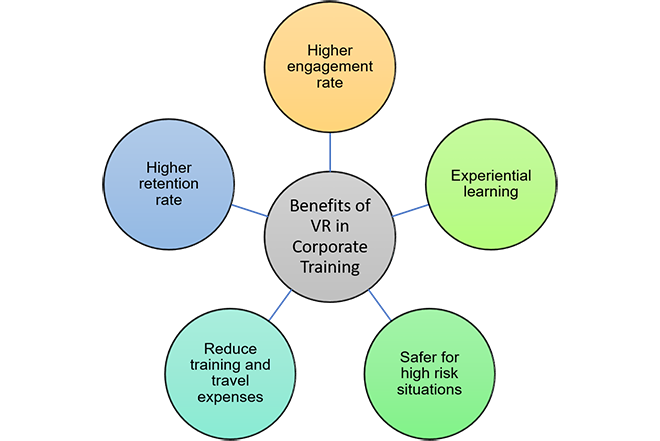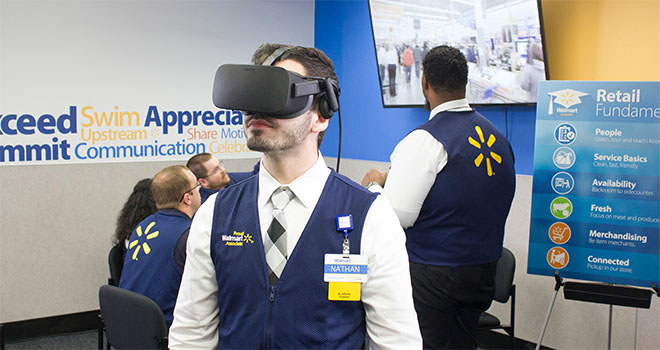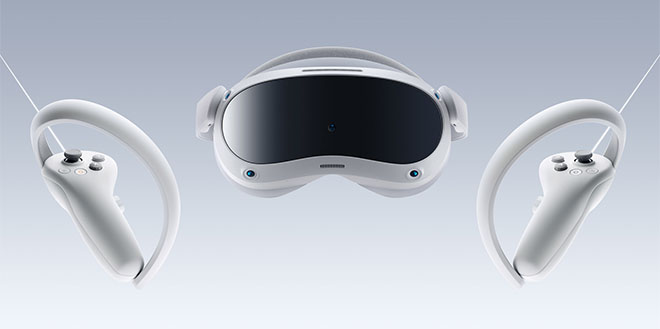VR for Corporate Training: Examples of VR in the Workplace
Updated June 22, 2023 - Sophie Thompson
While many continue to debate over the adoption rates of virtual reality (VR) and if it really will be 'the future', a VR tidal wave is quietly bringing VR very much into the present, and you could find yourself being trained in VR sooner than you think.
Tech giants like Apple are finally entering the fray, global companies like Accenture are buying Meta headsets in the tens of thousands for their teams to use, while public services such as healthcare and Police forces worldwide are beginning to adopt the technology. Companies right across the spectrum are now exploring VR as a supplementary tool for corporate training.
For those new to the concept of Virtual Reality, it uses 3D-generated images to immerse a user into a simulated environment so that they feel like they are actually there.
The argument for VR in corporate training is simple - it can increase engagement and knowledge retention levels, and employees can be trained in safer, more cost-efficient, and repeatable ways.
VR enables employees to learn through practical experience. Experiential learning has long been argued as the most effective way to learn and studies have shown that learning through experience increases the quality of learning, and retention by 75-90%.

Benefits of VR in corporate training include higher engagement and retention levels, experiential learning, safer for high-risk situations, and reduced spending on training and travel.
So, how is virtual reality being used in corporate training?
Improving business and soft skills
Business skills are not alone in that they require consistent practice to master them, and many of us probably don’t take adequate time to do so. VR provides employees with a safe space to practice these skills and learn from their experiences.
Skills such as public speaking, sales, negotiation, and networking are often considered vital to many aspects of our working lives, but rarely taught at school so are not embedded in our minds in the same way that remembering facts and figures for a test are. Yet it's these enterprise skills that keep businesses running and are consistently seen as vital requirements in new candidates and employees.
VR training enables companies to fill these skills gaps and instill transferable, enterprise skills within their employees.
VirtualSpeech specializes in this soft skills training, integrating traditional online classes with VR. The VR element allows employees to practice what they've learned in the courses in realistic simulations such as networking events, dealing with the media, and speaking in meetings and conferences.
- See the catalog of VR soft skills courses
VirtualSpeech helps employees improve communication and business skills in realistic environments.
Users can upload their own notes and slides, record speeches, watch their presentations back and receive instant feedback on their eye contact, use of filler words, pitch, pace, and more (see the full list of features).
They can also roleplay with AI-enabled avatars across Q&A sessions, as well as debates, interviews, performance reviews, sales meetings and more.
They can then practice further to improve their scores and feedback, even when working remotely. Managers also have the option to view their employees' progress to identify strengths and any areas for improvement, or even organize live, multiplayer practice sessions within VR to share progress and feedback.
Diversity, inclusion, and harassment training
Diversity and inclusion training has remained a firm focus area for many companies over the last couple of years. Traditional training in this area has some challenges; it is often reactionary and lacks impact, and is implemented as a box-tick exercise.
For a subject that focuses on empathy, VR offers the opportunity for employees to literally step into another's point of view, and be fully immersed in complex issues and scenarios that may be difficult to imagine.
One company using such a virtual simulation for corporate training is Mursion. They built a virtual tool in partnership with the College of William and Mary to reduce unconscious bias and improve communication between employees when confronted with discrimination.
Vantage Point is another company focused on sexual harassment training. Their training takes into account hard-to-detect nuances of common sexual harassment situations and teaches techniques such as bystander intervention, identification of sexual harassment, and on-response training.
VirtualSpeech released our own DE&I module this year, focusing on the day in the life of a young professional in the UK, and the profiling, stereotyping and microaggressions they receive on a daily basis. Many of these are subtle, and lots of learners will probably see themselves in the colleagues presented, but being on the other side of the table provides the needed empathy for effective learning.
VirtualSpeech for Business
Discover the benefits of VirtualSpeech VR training over classroom and self-paced e-learning.
Download eBookCustomer experience
Retail stores are also starting to use VR training to improve the customer experience. For example, Walmart have a long-standing relationship with STRIVR (previously known for training NFL athletes in VR) to create customer team training as well as a 'Black Friday' simulator to train and prepare employees for the holiday rush.
Hospitality can benefit too. McDonald's worked with Tantrum Labs to implement hospitality training, helping their employees to work through various scenarios with multiple choice options to help practice for customer complaints and conflict without real-life impacts.

STRIVR training a Walmart employee in a VR simulation.
For an in-depth look at how VR will enhance soft skills training, read our white paper:
Reducing risk in high-stake situations
The safety of the virtual world is not just good for interpersonal skills - it is the ideal training method for dangerous or high-stake situations. Before VR, employees would have to imagine a high-risk scenario and visualize how they would cope with it.
VR removes the need to imagine a difficult situation and instead replaces it with a realistic simulation. It provides an effective learning experience by training people in the most realistic way possible, without the situation actually happening in real life.
For example, Norcat worked with the mining company Vale to realistically recreate replicas of real-world mines and machinery for vital safety training without having to take all important equipment out of use.
Employees are able to learn from mistakes in the virtual world and become ultimately familiar with everything about their machinery and the real-world location, before ever setting foot on site.
Elsewhere, BP partnered with Igloo Vision to train their employees in start-up and emergency exit procedures at their oil refinery in Hull, England.
Employees were able to learn from mistakes in the virtual world and thus reduce the probability of making the same error in the real-world - an error that could ultimately cost someone's life.

Chemical engineers training inside an Igloo Vision dome.
Doctors and surgery
VR can also be used to lower risk in life-threatening situations in medical procedures. Surgeons in Rio de Janeiro, guided by teams at Great Ormond Street Hospital were recently able to practice and experiment with VR technology to prepare for a first of its kind procedure to separate conjoined twins.
Surgeons spoke of the benefits of being able to "see the anatomy and do the surgery before you actually put the children at any risk".
The benefit of using VR for corporate training in this situation, is that it is safe to make mistakes and learn from them - a doctor's performance is monitored and measured to assess where adjustments could be made in real life.
Of course, the time pressure is lower in a controlled training environment so doctors can consider their options more thoroughly in VR training than if they were training on the job.
This would allow them to make more informed decisions, at a quicker rate, for more patients, when faced with the situation in reality. Ultimately, effective VR training could save lives.
Osso VR surgical training platform.
An example of VR being used successfully in this sector is when the Johnson & Johnson Institute began looking to improve medical training for surgeons. They worked with Osso VR to develop immersive training for doctors to perform operations. The results saw a 230% increase in surgical performance.
VR training works on the premise of mistake-driven learning, allowing doctors to learn the best solution in a risk-free environment. The cost of making a mistake in the virtual world is nothing compared to the cost of human error in reality.
Training and preparing military personnel
The military has been using VR for years as a supplementary method of training. Military training includes flight simulations for pilots, battlefield simulations for on-ground soldiers, and response to battlefield injuries for medical personnel.
VR training is used as part of boot camp exercises (alongside traditional military training). VR has the unique ability to make the soldiers feel like they are actually on the battlefield and they can put their skills to the test, and build on them in a safe environment.
Teamwork, communication and the speed of reactions are all important factors in training an elite force, and can all be practiced and improved upon by using VR training.
The Virtual Squad Training System (VSTS) at Schofield Barracks in Hawaii use wireless VR training environments as part of their military training. Trainee soldiers are given a head-mounted display, motion trackers, and wireless weapon controllers that accurately reflect the size, weight and shape of real military weapons such as the M4 and M165.
They are then immersed in a combat simulator and can learn by practical experience, without putting themselves or each other in potentially fatal situations.

Virtual Squad Training System being used as part of their military training.
Given the nature of their jobs, soldiers must be able to adapt themselves to unpredictable and complex situations. VR simulations are a powerful tool for replicating these situations and ensuring soldiers are more prepared for a variety of combat situations.
Workforce productivity
Apple’s newly announced Vision Pro headset focused heavily on use by workers, providing a seamless tool to communicate with colleagues, infinitely expand your desktop space, and engage with your work materials. There were some fantastic features announced and it looks like Apple are confident this will change the workplace.
In previous, existing examples, DHL Express wanted to increase the skills and knowledge of people within their organization. Working with Immerse, they built a VR training platform to promote the principles of safe, efficient unit load device (ULD) stacking.
The new method was tested at 12 locations around the world and found 99% of participants felt it helped them work better and more efficiently.
Working with Gravity Sketch, Ford has been using VR to produce car mockups with impressive results. Being able to start in 3D and stay in 3D has improved productivity and transformed designer workflow. VR and Gravity Sketch allow designers to create a 3D sketch straight from their imagination.
Designing a car with Gravity Sketch.
Recruiting and onboarding
VR training can also be used to improve the recruitment and onboarding process within a company. Using an interview simulator, HR professionals and managers can practice asking interview questions to potential candidates and learn the questions typically asked, skills to look for, and warning signs about a potential employee.
This type of corporate training also extends to existing employees, who can receive virtual in-house training for internal promotions within a company.
The VirtualSpeech ChatGPT enabled avatar can help simulate interviews from both sides of the conversation, taking on the role of an interviewer or candidate, and offering real time feedback on the context and quality of a learners questioning or answers.
Once a candidate has accepted a job offer, the next step is the onboarding process. Onboarding is the first experience of training an employee receives and it can give them a good idea of the training they can expect as they progress with the company.
A company without an effective onboarding process is more likely to have lower employee retention levels and productivity. VR can vastly improve this process and make it more efficient and enjoyable.
New employees can be given an introduction to the company, a tour of the building, view multiple business locations, meet their manager, and much more - all in the comfort of their own home, before they've even stepped foot in the office.
VirtualSpeech roleplay simulator with ChatGPT. Interview practice in VR can be extended to train HR professionals and managers.
Onboarding in VR can allow employees to experience the company culture and daily life in their role before their first day, making them feel more confident when they do start.
Virtual training can also set a universal standard for onboarding for MNCs with multiple locations around the world. If every location followed the same structure for virtual onboarding, retention and productivity of employees would increase, while costs would decrease with a standardized process.
VirtualSpeech for Business
Discover the benefits of VirtualSpeech VR training over classroom and self-paced e-learning.
Download eBookBarriers to the adoption of VR training
Despite the benefits of using VR for corporate training, there are barriers to adoption that are holding companies back. The short-term cost of implementing VR training can be higher than traditional methods because of the initial investment of purchasing the VR headsets.
However, newer headsets, such as the Meta Quest 3 and Pico 4 standalone headsets, have proven very popular as they are more cost-efficient than other VR headsets historically and are more portable than desktop-based options.
This means employees are able to loan the headset from their company to complete their training and return it afterward.
While Apple’s Vision Pro is almost 10x the price of these headsets, there is precedent for companies to invest that much in a quality product, with Varjo 8k mixed reality headsets costing thousands of dollars but offering unique opportunities for environments like Engineering and Design.
- Learn more about the Advantages of Meta Quest / Pro for Corporate Training.
It's not just the purchasing of hardware that needs to be considered when balancing the budget. Initially integrating VR training with existing LMS and customizing the training for your particular brand can both add to the cost of uptake. With such a new, evolving technology, the risk of ensuring ROI is higher than for traditional training methods.
3D Repo is working with companies such as Balfour Beatty and Highways England to deploy a Virtual Reality (VR) simulation for health and safety training.

The Pico 4 headset was announced in 2022, with an Enterprise model available that includes eye and face-tracking technology.
Of course, the main reason for introducing VR training is to benefit employees but there is a risk of backlash or resistance.
There may be a small percentage of people who don't want to use VR - they may simply not want the headset on their face, they may be averse to new technology, or have had a bad experience with motion sickness in the early days of VR, which has put them off trying it again. (In our experience, less than 1% have this problem in reality.)
Hygiene is also a factor to consider, especially as companies return to group work and training following the pandemic, with shared devices needing to be cleaned or sterilized between use which can add extra process, cost or uncertainty.
That being said, as the barriers to entry decrease and more companies introduce VR to their training catalog, all while reporting positive results, the perceived risk will lower for more cautious managers, and we'll likely see VR training as standard.
As millennials make up an increasing proportion of the workforce and Gen Z start to enter it, companies will have to adapt to their behaviors, working styles, and preferred methods of training - which are likely to be technology-focused and geographically dispersed.
The future of VR in corporate training
Companies are already implementing VR as a tool for corporate training. From public speaking to medical procedures, to training for dangerous situations, VR provides a realistic, safe training environment for employees.
Despite the initial set-up cost, managers are realizing the long-term reduction in cost and the ROI in terms of engagement, safety, and retention of training in VR. As the VR industry develops and more becomes possible in a virtual setting, training in VR will become commonplace.
Corporate training will be an important step into mass consumer adoption of virtual reality, as more people realize it's beneficial to so much more than gaming.
